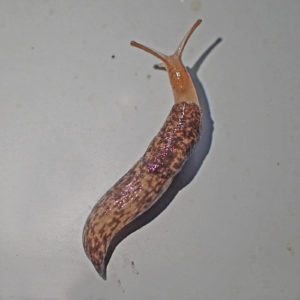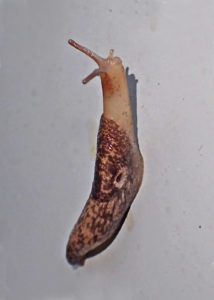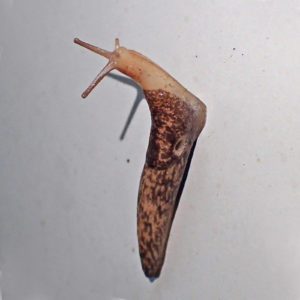Salutations, BugFans,
The BugLady found this impressive (1 ½” to 2”) slug climbing around on her cottage in early October. It has been almost 11 years since we last considered slugs (time flies!). For a quick Slugs 101 review, see https://uwm.edu/field-station/slug/. Recent BugFans please note that slugs, while not insects, are fair game because BOTW uses the kindergarten definition of “bug,” not the entomological one. Thanks (as always) to the very versatile BugFan Mike for help with the ID.
One reason that slugs seem so foreign to us is that they lack familiar landmarks like legs, wings, and body segments. So, what are you looking at when you’re looking at a slug? They lead with two pairs of retractable, regenerate-able, sensory tentacles. The top (dorsal) pair, which is used for sight and smell, has eyespots at the tips (slugs can see light and dark and blurry shapes but can’t focus on images), and the lower pair is used for smell, taste and touch and to move food to the mouth. These four appendages can be aimed in different directions simultaneously, but the lower pair is often pointed downwards in order to pick up cues from the slug’s substrate. The mouth, complete with rasping “teeth,” is on the underside of the head.
A saddle-shaped cover behind the tentacles, called the mantle, protects the slug’s innards; there’s an all-purpose opening on (almost always) the right side of the mantle called the pneumostome (one author calls it a “blowhole”), which has reproductive, excretory, and respiratory functions. Beyond the mantle is the tail. The muscular lower surface of a slug is the “foot;” its rhythmic undulation allows the slug to move, and it produces the infamous mucous/slime that keeps its body moist and “greases” its passage.
About that slime. It’s a multipurpose substance that is both sticky and slippery, that aids in locomotion (some species use it as a bungee cord), that absorbs water, that protects slugs from bacteria and fungi, that leaves a trail for the amorous (and the carnivorous) to follow, and that discourages predators. The BugLady found a tantalizing note about Hermann Lons, a German poet and malacologist (mollusc specialist) who discovered that slug slime tastes awful “in a particularly remarkable self-inflicted experiment” (about which she could find no further details). Slug slime is also the strong yet flexible inspiration for researchers trying to develop a next-generation surgical adhesive.
Evaporation and slime production constantly rob slugs of their water reserves. They can tolerate microclimates with a range of humidities as long as they can replenish liquid by eating and by absorbing water through their skin. In hot, dry summer weather or when food is scarce, they will aestivate under debris or dirt, and they can fast for several months.
To place slugs within their proper taxonomic sphere, they are in the very diverse Phylum Mollusca (octopi and squid, scallops and oysters, snails and slugs), in the Class Gastropoda (“belly-foot” – snails and slugs), and in a land slug family named Agriolimacidae.
The GRAY FIELD/GARDEN SLUG (Derocerus reticulatum, aka Agriolimax reticulatum), one of about a dozen slug species in Wisconsin, is a European slug that’s described throughout both its historic and its more-recently-embraced ranges as a “synanthrope” – a species of plant or animal that lives in habitats modified by humans and that benefits from human association. “Syn” means “with” and “anthropos” means “man,” and the term is applied equally to species we like (Golden retrievers) and species we don’t (Norway rats). Across the Pond, it’s found in Western Europe and Africa; but it has hitchhiked (oh, so easily) pretty much around the world. In North America, it’s found across southern Canada and the northern tier of states, plus a smattering of Central, Mid-Atlantic and Pacific Coast States. It likes gardens, agricultural fields, roadsides, parks, and greenhouses.
Slugs are hermaphrodites, which means that they have both male and female reproductive organs – an individual can be the fertilizer or the fertilizee’ (and they can self-fertilize), and all can lay eggs. In our area, Gray field slugs reproduce in late summer and early fall – Mom-Dad meets Dad-Mom in an elaborate dance that involves slime, a chase, and the waving of the sacrobelum. Eggs (as many as 700 in all) are laid in small bunches under stones and leaves and in crevices as fall rains soften the soil. They generally overwinter as eggs, hatch in spring, mature by late summer, and die not long after laying eggs.
Gray field slugs, notoriously, feed on the leaves and fruits of a wide range of agricultural and horticultural plantings and tree saplings, damaging leaves by rasping random holes in them. They are also scavengers that eat dead, soft-bodied invertebrates like worms and other slugs.
One of the questions that the BugLady always asks when she’s researching is “What does it eat?” and the next question is “What eats it?” Members of the ground beetle family Carabidae are important predators of Gray field slugs both here and abroad. This beauty, a (coincidentally) European ground beetle that is now established here and is a fellow synanthrope, is a slug connoisseur https://bugguide.net/node/view/632699/bgimage (business end https://bugguide.net/node/view/1566065/bgimage). The Gray field slug, however, can detect the odor of its ground beetle stalkers with those sensory tentacles, and chemicals mimicking ground beetle scents may have a future in crop protection.
When a ground beetle or other predator grabs a Gray field slug, the slug waves its tail back and forth and throws out lots of unpleasant, milky-colored slime (normally, its slime is clear). The final trick in its playbook is to break off the tip of its tail and leave it in the mouth of its attacker as it scoots away.
Gray field slugs operate within a home range where they revisit food plants and home sites. The BugLady’s slug notwithstanding, they tend to be nocturnal, and Wikipedia tells us that they can travel as far as 40 feet in one night.
Fun Slug Fact: when a slug ambulates across a copper surface, the copper reacts with chemicals in its slime and gives the slug a little shock.
Another Fun Slug Fact: the defensive slime produced by the Australian Red triangle slug is so sticky that it can glue a pursuing frog to a branch. For days.
Final Fun Slug Fact: if you get slug slime on your person, it will be easier to remove if you let it dry and then rub it with a cloth than if you wash it with soap and water.
The BugLady looked around for a nice, uplifting literary quote about slugs. She couldn’t find any. They’re all allude to slugs’ perceived negative attributes, like this “We have descended into the garden and caught three hundred slugs. How I love the mixture of the beautiful and the squalid in gardening. It makes it so lifelike” (Evelyn Underhill); and this, “Bob Dylan impresses me about as much as …well, I was gonna say a slug but I like slugs” (Don Van Vleit); and this, “It seems to me the worst of all the plagues is the slug, the snail without a shell. He is beyond description repulsive, a mass of sooty, shapeless slime, and he devours everything” (Cecelia Thaxter). Oblivious to the fact that slugs are, yes, perfect (and that possibly they find us repugnant).
Slugs in poetry? The BugLady found this wonderful poem by George T. Watt; it’s dense, but lean into it and read it a few times http://www.scottishpoetrylibrary.org.uk/poem/slugs/ (Note – Ein Heldenleben – “A Hero’s Life,” is a work by Strauss).
About slugs, Watt goes on to say that “Slugs haes trevelled awa on its ain journey, ye maun tak it whaur it’ll gang.”
Words to live by.
Kate Redmond, The BugLady



